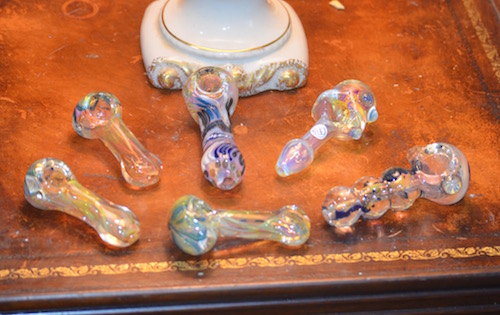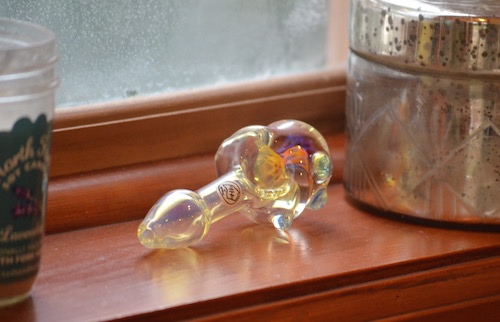What is Chameleon Glass
Chameleon Glass
There is nothing more personal – more sacred – than choosing a glass pipe. It is both a smoking device and a show piece. However, there are so many to choose from and quite a bit of jargon used to describe them. Without knowing exactly what you’re getting yourself into, the purchasing of a pipe can either be the best, or worst, shopping experience of an avid smoker. No need to worry – we’ve got you covered. Specifically, we are going to look at glass pipes in reference to the Chameleon Glass – how it’s made, what exactly it does, and some of the ins and outs of choosing between types of chameleon glass options.
First off, we need to understand what we mean by chameleon glass. Over the past decade, the amount of color changing pieces has grown exponentially. Basically, any pipe that changes colors due to use is chameleon glass. The best way to tell if a piece is color changing (by design and not because of a lack of cleaning) is to look for a foggy hue to the glass – almost as if there is residual smoke left inside. The piece should not be completely clear. This is the best way to tell if the piece is truly chameleon glass. These types of pipes are hand blown – especially if made by a domestic glass blower. And these pipes can come in all sorts of thickness and overall quality so just be mindful when shopping around.


How does Chameleon Glass work
Chameleon glass is made by vaporizing a metal alloy (often silver or gold) into the piece itself. This allows the metal ions within the piece, along with resin, to refract the light hitting it differently. Imagine a prism refracting light and creating a rainbow and the same is essentially being done with the chameleon glass – except that there is more control in what colors will be reflected in the glass (i.e. not simply a rainbow, but the glass artist can just about choose individual colors). So, with extended use of a pipe, as the resin builds up, the glass continues to develop a deeper, richer array of colors than the foggy look it maintained when originally purchased. As such, once you clean the pipe you will return it to its original foggy look only to begin the adventure once again!
Again, chameleon glass only refers to the color changing nature of the glass – do not be sold into buying poorer quality pieces because they advertise chameleon glass. Ever since the 1980s chameleon glass has been popular on the market – in other words, nothing too special in and of itself. If you want proper, high quality chameleon glass you will need to make sure that you research your provider. The biggest red flags are those that are imported or mass produced domestically. This is because the care and quality of the glass cannot be verified for imports and mass production have a tendency to lower the individual quality of the pieces (in the same way that it lowers their price). Don’t be oversold poor quality materials because of a few familiar buzzwords.
Chameleon Glass Pipes & Bongs
Because of the massive popularity, producers often make chameleon glass pipes and bongs in various shapes and sizes. As far as making sure you choose the right one you first need to ask yourself this question – what do I want to use it for?
A pipe and a bong operate differently and provide different experiences. This first initial consideration is critical – do you want a stronger, cooler experience or a milder, hotter one? The hand pipe has not water where the bong is designed for use with it, and the addition of water inside will filter the smoke, cooling the smoke for a smoother hit. The water makes it easier to handle harsher loads when smoking, however, this is not always as casual and requires more maintenance to ensure the quality and experience of the smoke remains – aka make sure to change the water often.
Hand Pipes, however, are often smaller, less intricate, and better for the more casual consumer. Their portability is often one of their best features – you can move with it almost anywhere with general ease and no worries. Bongs are not as portable but deliver quite a bit of punch – in other words you will certainly feel a degree of bang for your buck. There are more parts on a bong too, and the cleaning regimen can, at times, be more difficult than a pipe – but that also depends on how intricate, detailed, and specialized your bong is with accessories. Pipes, generally, are more straightforward. They can come in a variety of sizes and styles (adding to their difficulty to clean) but generally don’t have the same maintenance needs as a bong. This is not to say that either will not get the job done, both pipe and bong can suffice to get the job done. A good glass piece will serve you well regardless of the product being consumed.
How to choose a Chameleon Glass Pipe
Once you have decided whether you prefer a pipe or a bong, you really need to take into account the specific tastes you have. For example, is portability your biggest concern? If you travel often or enjoy bringing your piece with you there will be differences in between different pipes and bongs and how easy they are to transport – plus you may not want to spend a fortune on something that can be subject to slippery traveling hands.
Are you more of a casual smoker? If so, you may not need a pipe or bong with as large of a bowl as some others – especially if this is solely for individual use and not to be used in groups or parties or gatherings. Remember, there is no such thing that ‘thicker is always better’ – thicker certainly helps but you should also pay attention to the quality of the glass producer. As with anything, the way your piece is made will do more to determine your overall lifespan and experience than anything else you will come across. Remember the key rule – always choose a piece, or narrow down your choices, based upon your desired function and how well that piece fits your purpose. The coolest piece may not function the best for your needs and you will certainly not remain happy for very long.
How to choose a Chameleon Glass Pipe
Cleaning your chameleon glass does not have to be any more of a hassle than regular glass. As we said earlier, chameleon glass is just glass with metal ions vaporized into it to allow color changing – especially when there is resin collected inside the piece. Otherwise, there is absolutely nothing to worry about in respect to special cleaning instructions. In fact, you can choose to use industrial or commercial cleaners as well as household concoctions that may have served you well in the past – all are safe in the cleaning of chameleon glass.
When you have decided you want to reset the clock on your pieces color changes you will want to make sure that all of your herb is out of the bowl piece. This will help reduce the amounts of physical contaminants that remain inside the piece. Next, you will want to grab your favorite cleaner and begin to introduce it into your piece. Make sure that the cleaner meets all the resin touching the glass surface – this is the most caked on resin and is imperative to remove to return to the clean, foggy appearance you purchased your piece with.
Placing the piece in a bowl or bag so that the cleaner can fill the pipe interior via the various holes is a must. This will allow you to shake or otherwise manipulate the cleaning agent inside and around the piece. This creates more friction and contact between the resin and the agent breaking down the connections between the two. You should be able to see that the resin is breaking away from the surface of the glass and that there is quite a bit of resin mixed with the cleaning agent. To help speed up the process, feel free to use a paper clip, dabber tool or something else to scrape the resin and speed up the process.
When you seem to be satisfied, drain the 420 cleaner from the pipe. If there is still a lot of build it, it is recommended that you reapply the cleaning agent to further break down any surface tension and residue that may remain within the piece.
Once you have repeated these steps and are satisfied with the cleanliness of your piece you should rinse out the remaining residual cleaning agent with warm water and allow your piece to drain and dry on a paper towel, rack, or wherever best suits you. In addition, don’t forget to use your lighter to make sure there are no residual chemical traces that you missed when you rinsed out your piece. You do not want the impurities of the chemical agent residue to hamper your future consumption.
Cool Glass Artists that use Chameleon Glass
Now that we have discussed the ins-and-outs of chameleon glass – let us talk about who makes it. There are a million options on the internet that all require your further research into the subject and their business practices, however, we have three USA glass artists we like to showcase for their quality:
Cherry Glass of Northern Minnesota
This is a custom, hand-blown glass outfit. These pieces are of high-quality glass chillum pipes and are beautiful to look at. Scott Bennet, the glass blower in question, has been recognized by a number of publications – most recently High Times in 2015. They are most well-known for electroforming dead bugs and sea life to glass spoon pipes.
Tedrow Glass
Another quality brand that is sold through various third-party vendors. These pipes are cool, quality, and best of all – easy to clean. Their straight-forward design is awesome for beginners and experienced, casual smokers alike. A classy piece indeed.
Ohio Valley Glass
These glass blowers offer a variety of styles of pieces that can suit your needs and, of course, they are all of quality. From chillum pipes to Sherlocks and spoons, Ohio Valley creates a diverse inventory for any smoker to enjoy.

Where to get Chameleon Glass
As we said earlier, chameleon glass is common nowadays and you can find pieces sold anywhere – even gas stations. But that doesn’t mean they are quality. In fact, your best bet is probably going to be searching for your favorite glass pipes online – unless, of course, you know the guy at the local, independently-owned headshop real well. There are quite a few online options but few offer the variety, quality, and Free Shippingthat nyvapeshop.com can!